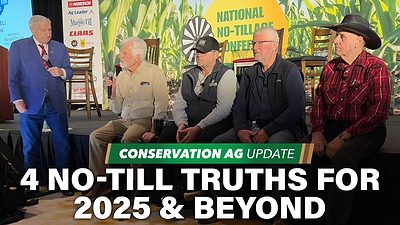A short growing season in the Northern Plains means farmers are getting creative in their use of soil health building practices like conservation tillage and/or cover crops. A primary concern of farmers when converting to a reduced tillage system is that having residue on the soil surface could result in fields being slower to warm and dry in the spring.
This concern is especially directed towards soils that have a high clay content and poor drainage, like in eastern North Dakota, Manitoba and western Minnesota. Farmers who have made or are making the transition to reduced tillage systems work hard to manage residue out the back of the combine and often add cover crops to their rotations to help further build up or break down residue and regulate moisture and temperature.
One creative approach being used — especially in the small grain phase of the rotation — is a concept called bio-strip-till. The goal of this approach is to concentrate specific cover crops in strips across the field in preparation for the cash crop the following year.
It helps to potentially cut back on costs by targeting efforts in strips vs. the entire field, concentrates cover crops within those strips and helps to manage residue not only from the prior cash crop, but also from the cover crop. This concept is similar to strip-till, only using plants.
Cover crops selected for the strips are often chosen considering 3 factors. First is carbon to nitrogen (N) ratio, including high N, low carbon cover crops like brassicas, to break down straw from the small grain crop.
The second consideration is need for the following year’s crop, including using flax which forms relationships with mycorrhizal fungi to prime the soil for the following years corn crop. Finally, consider the color and structure of the residue from a decomposing cover crop to help warm the soil.
“Strip-till cover crops are selected on three factors…”
For example, using fava beans in-row for their upright, dark residue after winter-kill and using peas between-row to keep viney, light colored residue away from row units on the planter.
Spacing of the bio-strips is based on the row spacing of planting equipment for the following spring. If planted corn or edible beans are on 30-inch row spacing, the bio-strips are seeded on that same 30-inch spacing. Sometimes the 30-inch row spacing for the cash crop is split by shifting 15 inches over and seeding a different cover crop mix.
Farmers then will have cover crops on 30-inch row spacing or 15-inch row spacing depending on what they are seeding and their specific goals associated with the bio-strips.
When using this approach, pay attention to equipment settings when seeding cover crops on the bio-strips.
Be sure to check residue managers on the planter to make sure they aren’t set too deep and create a trench in the soil where the bio-strips are. This is especially important when going to a cash crop like edible beans on those bio-strips that need to be harvested close to the ground.
Since bio-strips are also intended to dry out faster in the spring relative to the residue between row, having water or snow melt accumulate in trenches created by residue managers can create issues in the spring.
If using an air seeder, some residue may inevitably be chopped up and create a mat on the surface. This could cause issues between rows with being too wet or it could be desirable. Check and set equipment appropriately because cover crops aren’t the silver bullet for everything, especially when equipment settings can cause some issues.
Bio-strip-till is an interesting way to use cover crops for managing several issues when already using or converting to a reduced tillage system, including but not limited to soil warming and drying.





